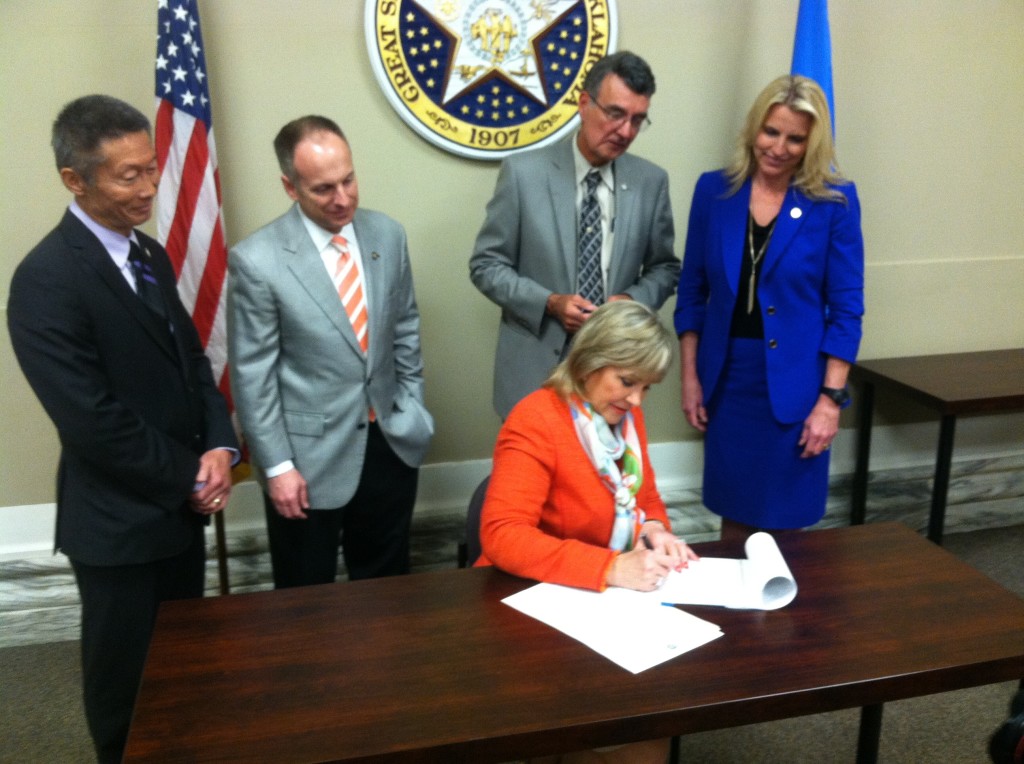Governor Fallin today signed legislation taking aim at Oklahoma’s prescription drug abuse problem, the first bill to be signed into law in 2015. House Bill 1948 seeks to reduce “doctor shopping,” the practice of going to multiple physicians with requests for prescription narcotics, and to reduce the reliance on and inappropriate use of dangerous narcotics to treat pain.
The law requires doctors to check a Prescription Monitoring Program (PMP) database before writing prescriptions for potentially dangerous and addictive drugs like oxycodone. By checking the database, doctors can reduce the likelihood that patients are seeking the same prescription drugs from more than one physician at a time.
“Sadly, prescription drug abuse in Oklahoma is nothing short of an epidemic,” said Fallin. “There are more fatal overdoses in Oklahoma involving hydrocodone or oxycodone than alcohol and all illegal drugs combined. In 2013, there were more overdose deaths than fatal car accidents. As a state, we need to take a stand and say ‘enough is enough.’ That’s what we have done today by strengthening our PMP system and targeting doctor shopping.”
Fallin has been a consistent advocate for stronger PMP legislation as well as additional resources for substance abuse treatment and prevention during her time as governor. Under her leadership, the state has developed and begun implementation of a comprehensive state plan to address prescription drug abuse. Fallin has also successfully fought for additional funding for the Department of Mental Health and Substance Abuse Services (ODMHSAS).
“My thanks go out to the Legislature and the many health advocates who made sure this important bill got to my desk,” said Fallin. “A lot of hard work went into crafting this legislation. The reward will be well worth it when we reduce the number of lives lost and families torn apart by prescription drug abuse.”
HB 1948 was authored by Rep. Doug Cox and Senator A.J. Griffin. It passed 64-30 in the House and 35-10 in the Senate.
Cox, a doctor, thanked other medical professionals for their support of the legislation.
“I applaud Governor Fallin for leading on addressing prescription drug abuse and I am thankful for all of the hard work by Senator Griffin,” he said. “I am pleased my medical colleagues recognized the problem and are willing to step up and be part of the solution. I am thankful that doctors and their staff are willing to sacrifice time and resources to help make strides in addressing this serious issue facing Oklahoma.”
Griffin said the issue of prescription drug abuse has been a long-time priority for her.
“One of my top priorities since first being elected senator has been writing and passing laws to reverse Oklahoma’s epidemic of prescription drug abuse,” said Griffin. “Too many families have watched as prescription drugs have taken over the lives of their loved ones—and too many of those lives have ended far too soon. This new law will give us an important tool in fighting prescription drug abuse in Oklahoma, and I thank my fellow members and Governor Fallin for their support.”
ODMHSAS Commissioner Terri White said that while prescription drug abuse is a significant problem in the state, it is a problem that can be successfully addressed through public education and changes to prescribing policy and practice.
“Utilization of the PMP system by prescribers has the potential to save lives,” said White. “This is a tool that will aid providers in appropriate prescribing, in addition to significantly impacting the misuse of these powerful, addictive medications. Addressing this problem is up to all of us. We all have a role to play. This is one step of many on the road to helping stop prescription drug abuse in Oklahoma.”
More on Prescription Drug Abuse in Oklahoma (Source: Oklahoma State Department of Health)
- The drug overdose death rate increased nearly fourfold from 1999-2013.
- In 2013, drug overdose deaths were the leading cause of injury death in Oklahoma.
- There were more drug overdose deaths (any intent) than motor vehicle crash deaths.
- In 2013, 85% of drug overdose deaths in Oklahoma were unintentional.
- In 2012, Oklahoma had the fifth highest rate of opioid painkiller prescribing in the nation.
- In 2013, Oklahoma had the sixth highest unintentional drug overdose death rate in the U.S.
- From 2007-2013, more than 4,600 Oklahomans died of an unintentional poisoning.
- That is 13 people every week
- 78% of unintentional poisoning deaths involved at least one prescription drug
- Prescription painkillers (opioids or narcotic analgesics) are the most common prescription drug.
- Prescription painkillers were involved in 9 out of 10 prescription drug-related overdose deaths.
- Prescription painkillers were involved in 465 unintentional overdose deaths in 2013.
- In Oklahoma, more overdose deaths involve hydrocodone or oxycodone than alcohol and all illicit drugs combined.
- Overall, men are more likely to die of an opioid-related overdose than women.
- However, deaths are increasing faster among women than among men.
- Women age 45 and older have a higher rate of prescription drug overdose deaths than men.
- Adults age 35-54 have the highest death rate of any age group for both prescription and non-prescription-related overdoses.
- Factors that contribute to the prevalence of prescription drug abuse/misuse include misperception about their safety (many people assume they are safe to take under any circumstances); increased environmental availability; inappropriate use of powerful and addictive opioids to treat pain; self-medicating to get high, counter anxiety, pain or sleep problems.



